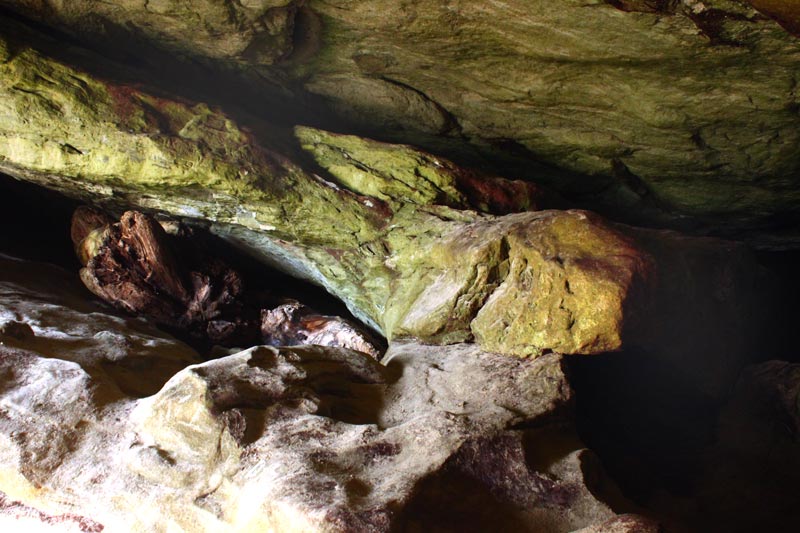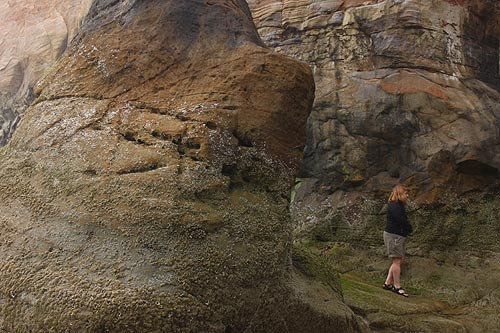Curiosities, Ancient Surprises Near Cannon Beach, N. Oregon Coast
Published 07/22/21 at 6:25 PM PST
By Oregon Coast Beach Connection staff

Includes exclusive listings; some specials in winter
In Cannon Beach:
Includes rentals not listed anywhere else
In Manzanita, Wheeler, Rockaway Beach:
Some specials for winter
In Pacific City, Oceanside:
Some specials for winter
In Lincoln City:
Some specials for winter
In Depoe Bay, Gleneden Beach:
Some specials for winter
In Newport:
Look for some specials
In Waldport
Some specials for winter
In Yachats, Florence
Some specials for winter
Southern Oregon Coast Hotels / Lodgings
Reedsport to Brookings, places to stay; winter deals
(Cannon Beach, Oregon) – Scenic pleasures and wild to mild means of repose abound at Hug Point, just south of Cannon Beach, with that waterfall, a cave or three, and the old road carved out of the rock. Crusty creatures emerge with regularity inside the tidepools here, which change locations on occasion. Calming to slightly crazed conditions create a fun tideline experience, while winter can bring enormous storms that fill the cove area with insane oceanic chaos, creating an astounding spectacle.
This would seem enough for any Oregon coast hotspot. Yet there's not only more than meets the eye here, there's quite literally more beneath the surface than you'd imagine. Hug Point in a very real sense works on a lot of levels, both in time and space. That means to really get to know this north Oregon coast favorite you have look closer, a bit beneath the surface perhaps, and check it out at various points in time.

Hug Point's story goes back well over 100 years, to when all the beaches were the only roads up and down the length of the Oregon coast. That meant, however, much of it was only passable at lower to even low tides, causing mail trucks or delivery vehicles to get stuck for days. No overnight packages here. This state park was one of the worst spots for this with the pointy, well, point jutting out into the sea. So early Oregon officials decided to blast a road around the point, creating that unique feature you see today.

You can still see the ruts dug into the old rock by those ancient vehicles.

It is an awesome feature, unlike anything on the entire Oregon coast. But right next to it is the enormous, shudder-inducing sea cave that is also unforgettable. Inside, the colors get wild and strange, and you see giant chunks of driftwood crammed into spaces in odd ways, displaying the power of the ocean that put them there.

Two curiosities lurk on that road: one is the occasional chunk of wood bolted into the face, closer to the northern side; and the other is a tiny brass knob embedded in the edge of the road. The board of wood appears then disappears every few years. While no one is sure exactly why it's there, it's believed either park rangers or locals put it there and attach a rope to it, in case anyone gets into distress because of the tides.

Exactly what the knob is or why it's there is also a bit of a puzzle. It has an elevation marking, but also the inscription of Pacific Power and Light. The company could not find any documentation on it, but they theorized it was originally used by the power company in the '20s as a survey marker.

When sand levels get super high, as in most summers, Hug Point becomes much larger. The tide is kept at bay, and you can even walk beneath that road in complete safety. But in winters, if the tide gets low enough, you can see wildly colored rock slabs just beneath the waves next to the road, often covered in tide pool life.

Winters are when Hug Point can really come alive. In the 2000's, the Oregon coast had a run of winters where ten feet or more of sand was taken off many beaches. At these extraordinary times, incredible objects came to light. Beneath these sands lie the remnants of a forest more than 4,000 years old – commonly called ghost forests. These, plus other stunning geologic wonders called “red towers” (surreal chunks of reddish clay-like material) showed up as well.
Not to mention, agates are prime at this spot when sand levels drop. This whole section of Oregon coast is a gold mine of dreamlike exploration.

Some details at Hug Point are staring you in the face but you don't notice them. And they're almost shocking.
One is the ancient carvings in the face of the rock surrounding the road. If you look closely at the slab that covers part of the old roadway, you'll notice a series of indentations. Some of this is just tidal melee, but some are the remnants of ancient handholds carved into it by native tribes. Pictures from the 1930's shows these as still more pronounced, but now they're whittled down a ways. Before this rock was blasted out, a whole series of these went up the rockface to the top, basically a crude ladder. They could be hundreds of years old or older.

The real shocker is the ancient petrified forests embedded in parts of Hug Point, millions of years old. Local geologist Tom Horning explains the sandstone here was formed about that time when this area was an estuary of the Columbia River. The petrified wood was – long story short – made by creatures making tiny holes, and then those holes were slowly filled up with sand, becoming sandstone.
Hotels in Cannon Beach - Where to eat - Cannon Beach Maps and Virtual Tours
Cannon Beach Lodging
Nehalem Bay Lodgings
Manzanita Hotels, Lodging
Three Capes Lodging
Pacific City Hotels, Lodging
Lincoln City Lodging
Depoe Bay Lodging
Newport Lodging
Waldport Lodging
Yachats Lodging
Oregon Coast Vacation Rentals
Oregon Coast Lodging Specials
More About Oregon Coast hotels, lodging.....
More About Oregon Coast Restaurants, Dining.....
LATEST Related Oregon Coast Articles
Through 2 a.m. likely best, but some lights possible through dawn June 1 - 2. Space weather, astronomy
Rare Sperm Whale Stranding on N. Oregon Coast, Was Hit by Boat
Showing up near Gearhart, it will decompose naturally. Marine sciences
Coast Guard Barque 'America's Tall Ship' Coming to Portland Rose Fest, N. Ore...
Portland events: June 5 - 8; Astoria events June 13 - 15. Weather
Bright and Active Arietids Meteors May Hit Pre-Dawn Hours of Oregon, Washingt...
Look to east hour before sunrise and you may catch a show. Sciences, astronomy, weather
Why Now Could Be a Great Week for Spotting Killer Whales on Oregon Coast - Video
A good dozen documentations around Depoe Bay, Newport, Coos Bay, Bandon, Tillamook. Marine sciences
Summer Road Work, Traffic Issues Along Oregon Coast Include Astoria, Garibald...
Some daylight closures include bridges, OR 22, OR 18, OR 26, more. Travel tips. Seaside, Cannon Beach, Lincoln City. Travel tips
Pacific City Oregon Weather, 7-Day Forecasts, Live Conditions, Radar, Webcams...
Updated Constantly: Pacific City, Tierra Del Mar, Oregon Weather, Cams, Buoy Observations, Tides, Warnings - Alerts
Oregon Coast Has World's Oldest Harbor Seal, Celebrating 50 Years Soon
June 3 at Oregon Coast Aquarium in Newport. Newport events
Back to Oregon Coast
Contact Advertise on BeachConnection.net
All Content, unless otherwise attributed, copyright BeachConnection.net Unauthorized use or publication is not permitted



















































